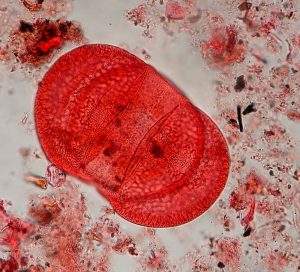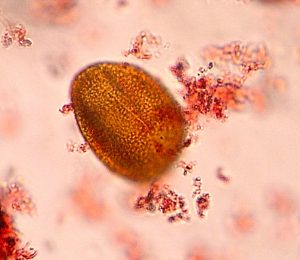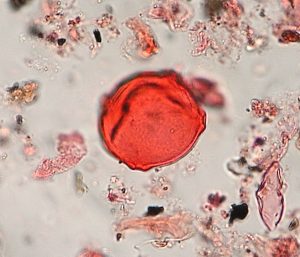01 Oct Palynology – pollen analysis
Pollen grains are male plant cells for sexual reproduction and transfer of genetic information. Their size is since 15 to 200 μm. Spores of ferns, mosses and horsetail are different and their role in reproduction is different. Plants produce huge amount of pollen grains, which are spread by wind or insect in environment and consequently can be deposited in suitable sediments. Seldom are pollen grains joined in four grains e. g. heather (Calluna vulgaris), or two grains. Coniferous trees have air sacs for easy wind spreading. Some pollen grains can be determining to species level, in central Europe it is for example some trees or several herbs such as plantain (Plantago sp.), cornflower (Centaurea sp.) or important crops such as buckwheat (Fagopyrum esculentum) or flax (Linum usitatissimum). Prevailing numbers of pollen types indicate genus level e. g. Apiaceae or Rosaceae family. Some plant families such as grasses or sedges can be determining only a family level.
Pollen records can bring information about changes of vegetation cover and human activities in the past in case of natural sediments or archaeological situations. Human activities are visible in vegetation changes, deforestation, agriculture practices or fire management. It can provide information of landscape and enable the environment reconstruction of past human populations. Different approach is in archaeological context, where a different pollen taphonomy can be expected. It does not reflect only local vegetation but mainly human activities such as crop transport and processing, animal feeding or long-distance trade (spice occurrence). Interpretation of this pollen spectrum is very hard without knowledge of archaeological context. Range of suitable localities for pollen investigation in central Europe is quite wide. It’s from mountain peatbogs as relatively natural environment to Mediaeval town waste reservoirs such as example of human made situation. In this range there are many situations, where we can study pollen record and human activities relationships. Alluvial deposits are the best example. They enable a preservation of the paleoenvironmental record and archaeological artefacts including organic tissues, which are otherwise decomposed.
Pollen grains have resistant sporopollenin cell wall, therefore there can preserve in various waterlogged situations, or extreme dry environment. Other suitable situation are surfaces of bronze artifacts, because copper is toxic and preserve pollen grains. In central Europe, natural pollen profiles are usually located in lakes, peatbogs, fens, river oxbows, alluvium or wet wash deposits. Archaeological situations are, due to their complexity and variability, very specific environment from palynological point of view. Most of dry archaeological contexts are not suitable for pollen analysis. Wet and organic layers, or in rare cases clay infills, such as water wells, waste reservoirs, wet ditches, manure layers or buried floors and surfaces, are the most convenient for pollen analysis. Generally, Mediaeval towns provide more opportunities for pollen preservation than for example Prehistory settlements located on the site with dry bedrock. Specific and unfortunately often neglected sources of pollen record are artificial water reservoirs, such as mediaeval fishponds.
In a frame of the ERCA Centre the palynological analyses are guaranteed by Mgr. Libor Petr, PhD. from the Faculty of Sciences of the Masaryk University in Brno.

Pollen grain of a spruce (Picea sp.).

Pollen grain of a buckwheat (Fagopyrum sp.).

Pollen grain of a hornbeam (Carpinus sp.).





